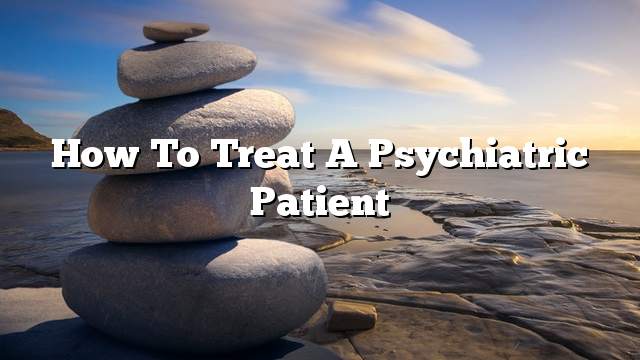Mental illness
Psychiatry is a different type of disease. It is widespread because a large number of people have been exposed to a type of mental illness at a certain stage in their life. These diseases are revealed by psychiatrists by diagnosing the disease in several ways, including observation, During the interview with patients, and therefore the treatment by the hands of doctors specializing in mental health, and receive people with mental illness treatment in mental hospitals, or to be limited to treatment in psychiatric clinics each patient according to his condition.
Definition of mental illness
Mental illness is a group of mental health conditions that lead to mood disorders, behavioral and mental, which feel the patient or around him bad, and prevents the patient’s mental illness from solving the problems in his daily life, and therefore can not live normally, and reaches the degree High despair, may reach the desire to die and attempted suicide, and over time changed ways to understand the cases of mental illness, until we got a lot of definitions of the subject of mental disorders and classification and evaluation.
Psychology divides the imbalance that occurs in the actions of the brain into three main sections:
- Mental disability appears since birth or at an early age.
- Psychosis that affects the individual’s perceptions and thinking in a big way.
- Nerves are the conditions of tension or anxiety or disturbance experienced by the human being and go without the need for intervention of a specialist, such as cases of grief or simple fear, or anxiety resulting from the pressures of life, and most of these problems disappear after the cause.
Treatment of mental illness
Doctors often use cognitive behavioral therapy to treat mental illness. There is also group therapy and other types of psychotherapy. These treatments may be used with or without medication.
Behavioral cognitive therapy
Many mental illnesses result from the negative thinking of the patient about the ocean and about life and its image of itself, and in his thinking many of the distortions and errors of discretion of things, bad thinking usually becomes like any other negative habit, and cognitive behavioral therapy to modify these ideas, and improves the image of the patient towards Himself and towards life and others through two therapists who are doing therapeutic sessions with the patient to recover.
Social therapy
The treatment of interpersonal therapy is based on the fact that some types of mental illness may be caused by work pressures or problems in social relationships and the personality of the individual. The aim of this treatment is to understand how the patient influences these factors and how Psychological illness, what are the possible treatments, and how the patient can avoid situations that may affect his mental health in the future.
Drug therapy
These are the most prominent drugs for the treatment of mental illness:
- Antidepressants are used to treat clinical depression, treat anxiety disorders and many other psychiatric disorders.
- Use antidepressants to treat anxiety disorders.
- Antipsychotics, used for bipolar disorder.
- Mood stabilizers, which are used to treat side effects of schizophrenia.
- Use of neural stimuli to treat mental disorders.
- These drugs are used in the treatment of many mental illnesses not referred to in the external label of the drug, in the sense that there is practice outside the scope of prescription drugs.
Other treatment methods
In certain cases of psychiatric illness, doctors may resort to treatment by means of electrical charges, but these methods depend on the situation and are used only in the advanced stages. There is also a trend towards the use of complementary methods that increase the effectiveness of the treatments and affect positively in many cases of psychiatric patients and Examples:
Types of mental illness
There are many divisions and classifications of psychiatric diseases, including disorders that fall under many diseases such as:
- Mood disorders: These disorders are related to the emotional state of the person and are also called emotional disorders, and include cases of fluctuation between absolute happiness and absolute sadness with a short interval, and excessive sadness or joy, for example bipolar disorder.
- Inventive Disorders: It deliberately introduces itself to the patient’s appearance to seek support and care from others without any physical defect.
- Tension disorders: It is a disorder in the patient that makes him make sudden movements or sounds that he can not control, and can not control.
- Emotional control disorders: People with such disorders may be dangerous to themselves and to the community. They are dominated by a certain kind of obsession and can not get rid of it. Examples of it are mania of fire or gambling mania.
- Psychological thinking disorders: These disorders are related to an imbalance in the person’s mind and an erroneous awareness of things, such as illusions and whispers that control the patient and are believed to be absolutely correct and realistic and are not so.
- Obsessive Compulsive Disorder: The patient has obsessive-compulsive disorder with certain stereotypical behaviors and rituals due to compulsive thoughts he controls, examples of which are bacteriostasis that causes the patient to wash hands excessively.
- PTSD: These disorders occur to some individuals after being subjected to severe trauma, such as being assaulted or shocked by the death of a loved one. The patient suffers from a state of continuous thinking about the event that caused the trauma or feeling numb.
- Personal Disorders: It is a pattern of maladaptive behavior, and characterization is unbalanced, for example, personality disorder.
